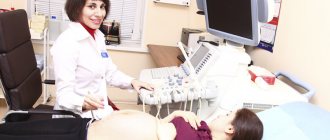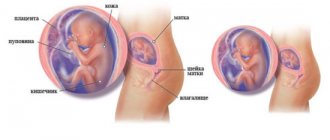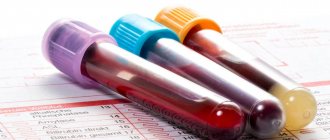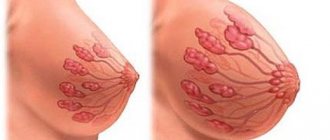Among chromosomal pathologies, Down syndrome occupies a special place - one of the most common genetic disorders in newborns. Its main cause is a random genetic mutation, as a result of which an extra third chromosome appears in the 21st pair of chromosomes. The frequency of the phenomenon is approximately 1 case in 600-800 babies. A random mutation leaves its mark on the child’s appearance already at the stage of intrauterine development, which greatly facilitates the diagnosis of Down syndrome using ultrasound.
Main causes
Modern medicine names two causes of the disease:
- Mother's age. This is a major risk factor for Down syndrome. The older the pregnant woman, the higher the risk of having a child with a random genetic pathology. At the age of 30-40 years, the risk of a genetic failure is 1/1000, after 42 years – 1/60. The main factor is the aging of eggs, which are laid during the period of intrauterine development of a girl and gradually lose the ability to form a genetically healthy fetus. The age of the father also matters - before or after 45 years, when the likelihood of having a baby with Down syndrome increases sharply.
- Hereditary factor. The cause of the development of the syndrome may be consanguineous marriages or the presence of the disease in one of the child’s relatives. The age of the grandmother at which she gave birth to her daughter also matters. The higher it is, the greater the risk of having a grandson with the syndrome.
It is important to remember: Down syndrome is recognized by specialists from all over the world as a random genetic mutation. It does not depend on the environmental situation, radiation levels, the presence of hazardous production and other extraneous factors.
Down syndrome: examination schedule and risk areas
Down syndrome is recognized today as the most common human chromosomal abnormality, the incidence of which is not decreasing. This is why experts are increasingly saying that more effort needs to be spent on helping children who have already been born, thereby improving their quality of life and increasing its duration. Here is a schedule of necessary examinations that can help with this.
Tasks of medical care
Usually the doctor focuses on medical problems, but there are psychological and social characteristics that affect the physical health of a child with Down syndrome and ultimately determine his achievements in the future. The goal of a pediatrician is to use not only medical resources, especially since an integrated medical-social-pedagogical approach ensures the success of the rehabilitation process for children.
An individual program is drawn up for each child, the implementation of which is supervised by a pediatrician, medical specialists, including a specialist from the rehabilitation treatment department. Parents are advised to keep notes about the progress of the rehabilitation process, because the situation will always be multifaceted, so you should not rely only on your memory.
Dispensary observation
Children with Down syndrome, like no one else, need to meet the deadlines for visiting the pediatrician and medical specialists, and in full.
Table 1. Timing of examinations of children by a pediatrician and medical specialists (number of examinations per year)
| Specialist | 0-1 month | 1-12 months | 1-2 years | 2-3 years | 5-6 years | 6-7 years | 9-10 years | 11-12 years old | 13-14 years old | 15-16 years old | 16-17 years old |
| Neonatologist (5) | 5 | ||||||||||
| Pediatrician (24) | 3 | 12 | 1 | 1 | 1 | 1 | 1 | 1 | 1 | 1 | 1 |
| Neurologist (14) | 2 | 2 | 2 | 1 | 1 | 1 | 1 | 1 | 1 | 1 | 1 |
| Orthopedist (10) | 1 | 1 | 1 | 1 | 1 | 1 | 1 | 1 | 1 | 1 | |
| Ophthalmologist (10) | 1 | 1 | 1 | 1 | 1 | 1 | 1 | 1 | 1 | 1 | |
| ENT doctor (9) | 1 | 1 | 1 | 1 | 1 | 1 | 1 | 1 | 1 | ||
| Surgeon (9) | 1 | 1 | 1 | 1 | 1 | 1 | 1 | 1 | 1 | ||
| Dentist (9) | 1 | 1 | 1 | 1 | 1 | 1 | 1 | 1 | 1 | ||
| Physical therapy doctor (2) | 2 | ||||||||||
| Speech therapist (4) | 1 | 1 | 1 | 1 | |||||||
| Psychologist-educator (9) | 1 | 1 | 1 | 1 | 1 | 1 | 1 | 1 | 1 | ||
| Dermatologist (4) | 1 | 1 | 1 | 1 | |||||||
| Gynecologist (5) | 1 | 1 | 1 | 1 | 1 | ||||||
| Endocrinologist (4) | 1 | 1 | 1 | 1 | |||||||
| Uroandrologist (3) | 1 | 1 | 1 |
Table 2. What problems will require special attention from specialists?
| Child's age | |
| Prenatal period |
|
| From birth to 1 month |
|
| From 1 month to a year |
|
| 1 year – 5 years |
|
| 5–13 years |
|
| 13 years old to 18 years old |
— changes during puberty and management of sexual behavior; — gynecological problems, primarily care for girls; - fertility problems, birth control, prevention of sexually transmitted infections, the risk for a person with Down syndrome to give birth to a child with Down syndrome.
- success at school and educational goals, including a plan for professional training (qualifications); — problems of guardianship and long-term financial support; - getting a job and place of residence - family relationships, forming a communication group and the possibility of independent living; - self-care and skills for independent living in society. |
| Over 18 years old |
|
* Compulsive behavior is an irresistible attraction to unseemly actions, although perceived as wrong.
- Assessment of physical development . From the first days of a child’s life, the size of his body is measured, because most children with Down syndrome are characterized by delayed physical development, primarily growth. When assessed, these data are compared with special (percentile) tables developed for babies with Down syndrome, and not with tables for healthy children.
- Features of feeding. The peculiar structure of the maxillofacial apparatus, low muscle tone, and immaturity of the nervous system in newborns cause difficulties during breastfeeding, but it is breast milk that they need to strengthen the immune system, prevent otitis media and speech disorders. It is important to maintain the correct position so that the child is comfortable and does not fall asleep while eating. Babies are fed slowly so that milk does not enter the respiratory tract.
- Cardiac problems. Congenital problems with various organs do not always appear in the first days of a child’s life, so children require additional examinations and supervision of specialists in many areas. More often, heart defects are detected in children with Down syndrome, so echocardiography is performed on everyone. Signs of particular concern are rapid breathing and blue discoloration of the nasolabial triangle. During the examination, a ventricular septal defect, a common patent atrioventricular canal, tetralogy of Fallot, fibroelastosis, conduction disorders and serious heart rhythm disorders may be detected. In children with Down syndrome, problems with lung function due to congenital heart defects occur earlier and more often than in other children.
- Respiratory system. It is important to understand the structural features of the upper respiratory tract in children with Down syndrome: narrowing of the nasopharynx and oropharynx, eustachian tube, external auditory canal. As a result, there is an increased risk that the root of the tongue will block the airway during sleep. Sleep apnea, although at different times, occurs in about half of children. We are talking about both complete cessation of breathing and partial difficulties. Obstructive apnea syndrome is often detected late and even missed, while it causes lethargy in children, sleepiness during the day, behavioral problems, forces them to take an unusual sleeping position (sitting, with their head thrown back, etc.), leads to decreased pace of development.
- Digestive disorders. In babies, they manifest themselves as regurgitation, bloating, disorders or stool retention, and then it will be important to exclude gross malformations in the child: esophageal atresia, tracheoesophageal fistula, pyloric stenosis, duodenal atresia, Hirschsprung's disease. A common occurrence in children with Down syndrome is gastroesophageal (gastroesophageal) reflux, which is caused by decreased muscle tone. In some cases, it is necessary to resort to surgery (fundoplication), where the upper part of the stomach is tightened around the lower part of the esophagus.
- Dental problems. Teeth, both temporary and permanent, appear in children with delays and according to a special schedule. Cavities often form between them, and the risk of developing gingivitis (gum inflammation) is high. Starting from the age of 2, the dentist examines children annually, and more often if necessary.
- Celiac disease. Down syndrome is associated with celiac disease in several genetic ways. Symptoms that may indicate this problem include: loose stools, severe constipation, slow growth/weight loss, abdominal pain or bloating, changes or abnormalities in behavior. Celiac disease affects a child's growth, bowel function and behavior. This problem is diagnosed in 3–19% of children. With Down syndrome, the possibility of developing celiac disease should always be remembered, and it can appear not only in the first year of life and is not always associated with the moment of introducing cereals into the baby’s diet.
- Sense organs. Children with Down syndrome are at risk for sensory problems and should be examined regularly by an ophthalmologist and ENT specialist. Possible eye diseases include congenital cataracts, nystagmus, strabismus, glaucoma, keratoconus, blepharitis and nasolacrimal duct insufficiency. Insufficiency or obstruction of the nasolacrimal duct is manifested by conjunctivitis, lacrimation, and when the nasolacrimal sac is massaged, tears or pus are released. Treatment of conjunctivitis involves massage of the nasolacrimal sac and local treatment with antibiotics. In some cases, the canal is probed. It is necessary to diagnose glaucoma, and, if necessary, surgical correction. Timely use of occluders, glasses, or both can help correct strabismus in time.
The high risk of hearing loss in children occurs due to difficulties with the outflow of fluid from the middle ear, caused by repeated ear infections, which lead to conductive hearing loss, and then to impaired speech development. It should also be noted that there is an increase in the secretion of wax in the ear canal, defects in the auditory ossicles and the accumulation of fluid in the middle ear due to problems in the functioning of the eustachian tube. Babies with Down syndrome should have an audiogram at 1 month of age and have their hearing tested in the future. For treatment, both surgical methods (adenectomy) and conservative ones (catheterization of the Eustachian tube, medications) are used.
- Endocrine system. In addition to consultations with an endocrinologist, the child needs to check the level of thyroid hormones. Disturbances in its functioning develop in half of children after they reach adolescence (but sometimes this happens earlier).
The tendency of people with Down syndrome to obesity, type 2 diabetes mellitus, the phenomenon of premature aging, graying of hair, etc. is well known. An assessment of a child’s diet, including the balance of food ingredients and calorie content, is necessary at each age stage. It is also important that children move more.
- Orthopedic pathology. Most common: atlantoaxial instability, scoliosis, hip dysplasia, subluxation or dislocation of the hip, instability of the patella, flat feet. For children with Down syndrome, this is due to the abnormal structure of collagen (VI) encoded in a gene located on chromosome 21. The result of overproduction of this gene is weakness of the ligamentous apparatus, which leads to hypermobility, instability of the joints, and their excessive mobility.
With the development of atlantoaxial instability, there is a risk of damage to the spinal cord if it is compressed by one of the cervical vertebrae. A lateral X-ray of the cervical spine will need to be taken if pain occurs, limitation of arm movements, head turns, walking, numbness or tingling in the arms or legs, or disturbances in bowel or bladder function. At the stage of up to 3 years, this diagnosis can be made erroneously based on radiographs; an MRI will be required for a more accurate diagnosis. A child diagnosed with atlanto-axial instability is prohibited from any movements that strain the neck muscles: diving, gymnastics, contact sports.
- Immunity and metabolic disorders. Because of the increased risk of developing infections (especially of the respiratory tract), children with Down syndrome should be protected from any unnecessary contact with sick people. It is important to carefully follow the vaccination schedule, although due to frequent infections, it has to be adjusted.
In the first months of life, metabolic disorders are often detected in the blood of children with Down syndrome: higher average levels of phenylalanine, galactose and thyroid-stimulating hormone. These features can serve as links in the development of psychoneurological disorders, so from time to time it is necessary to conduct studies of clinical blood and urine test parameters.
- Blood. Doctors are especially concerned about leukemoid reactions (transient leukemia), which are typical for 10% of newborns with Down syndrome. Although this condition goes away on its own, it is necessary to monitor the blood count in the future, as children are at high risk of developing common forms of leukemia. Another anomaly of the hematopoietic system, quite often found in newborns with Down syndrome, is thrombocytopenia, or vice versa thrombocytosis.
- Neuropsychic status. One of the significant consequences of Down syndrome is difficulties in speech development, and the goal of a set of educational techniques is to bring a child with Down syndrome to the maximum achievable level of development. Conduct disorders in children with Down syndrome are usually associated with communication problems, although they may have other causes, including attention deficit disorder (with or without hyperactivity) or autism. Since 5 to 10% of people with Down syndrome suffer from epilepsy, children need supervision by a neurologist and timely qualified examination.
Finally
An international team of doctors from European countries has developed guidelines for monitoring patients with Down syndrome. It defines the timing of certain medical studies for different ages, and this document is intended to become the basis for the development of appropriate standards in each specific country. In Russia, there is a medical examination program for children with Down syndrome, developed by employees of the Tver State Medical Academy; this issue continues to be addressed, among other things, by the International Association of Physicians Working in the Field of Down Syndrome (International Down Syndrome Medical Interest Group).
Characteristic external and other symptoms
People who are carriers of an extra chromosome have a characteristic appearance:
- flat bridge of the nose;
- Mongoloid eye shape, due to which the pathology has the second name “Mongolism”;
- flat face and back of the head.
Also among the features are some delay in development and reduced immunity, which does not allow the body to resist external infections. All of the above is not a limiting factor. Today, special teaching methods have been developed for them from the first months of life. If parents are active, children with symptoms of Down syndrome can receive secondary education and a profession, become full-fledged members of society and start their own family.
Are you experiencing symptoms of Down syndrome?
Only a doctor can accurately diagnose the disease. Don't delay your consultation - call
Diagnostics
Detection of a genetic abnormality is possible in the early stages of pregnancy:
- Ultrasound screening in the period 11-13 weeks evaluates the size of the nuchal space and the size of the nasal bone of the fetus;
- At the same time, a blood test is performed to determine the amount of chorionic hormone and plasma protein;
- in later stages of pregnancy, fetal tissue is collected for genetic testing: amniocentesis, chorionic villus fiber biopsy or cordocentesis.
Because We are talking about a genetic malfunction; treatment of Down syndrome consists only of monitoring the patient’s health condition and correcting complications of the underlying disease.
Prognosis for patients
Today, the average life expectancy with genetic pathology is approaching 55-60 years, whereas a few decades ago they lived only up to 25 years due to unfavorable living conditions.
The chance of having a child with a genetic abnormality in a person with Down syndrome is about 35-50%. In addition, during the formation of the fetus in a pregnant woman with the disease, the unborn baby may experience other genetic abnormalities.
At the same time, the risk of cancer in such patients is reduced to zero. In addition, parents note the cordiality and invariably good mood of such children, their affection, responsiveness, ability to easily make contact and not be offended by others.
Why are children born with Down syndrome?
No couple is immune from the development of Down syndrome in the fetus. This genetic abnormality occurs spontaneously. It does not depend in any way on the physical and mental health of the parents. However, women aged 18–35 years are more likely to give birth to a healthy baby. Scientists have proven that women who become pregnant after 35 years of age have a much greater risk of developing a chromosomal mutation than at a younger age. This is due to the aging of eggs. Another reason, which is very rare, is hereditary predisposition. If there are relatives in the family with Down syndrome, the chances of giving birth to an unhealthy baby increase significantly. In addition, doctors tracked the connection between the age of the grandmother who gave birth to her daughter and the chance of getting a grandson with a genetic anomaly. The older the grandmother was at the time of her daughter’s birth, the higher the risk of grandchildren being born with an extra 21 chromosome. The age of the father plays an important role. The risk group for conceiving a sick baby includes men over 45 years of age.
Prevention
It is not possible to completely eliminate the risk of having a child with a genetic pathology of the 21st pair of chromosomes. However, it is within the power of future parents to do everything possible to strengthen their own reproductive health and eliminate chromosomal failure:
- monitor your health, promptly seek medical help to treat identified diseases;
- lead a healthy and active lifestyle, exercise, so that enough oxygen reaches the eggs;
- eat right, enriching your diet with healthy foods high in vitamins and microelements;
- support the immune system;
- monitor your weight, because... its deviation in any direction can cause hormonal imbalance and disrupt the process of maturation of germ cells;
- undergo an ultrasound examination in a timely manner during pregnancy in order to identify a genetic malfunction in the fetus in the first weeks of intrauterine development.
Observation of patients with Down syndrome at JSC "Medicine" (clinic of Academician Roitberg) in Moscow
JSC “Medicine” (clinic of Academician Roitberg) operates a Center for working with special children. Pediatricians and specialized specialists at the clinic in the Central Clinical Hospital in Moscow are ready to work with patients with Down syndrome, regardless of their age and general condition of the body.
Patients are guaranteed attentive and responsible attitude, individual approach, confidentiality of personal data and achievement of visible results of the prescribed treatment or prevention of Down syndrome. All necessary diagnostic procedures can be completed in the clinic to obtain quick and reliable results.
To make an appointment and additional consultations, you can call +7 (495) 775-73-60.
Down syndrome – a sentence or hope?
Down syndrome is the most common genetic abnormality caused by trisomy 21 pairs of chromosomes. According to statistics, approximately 1 in 700 children are born with Down syndrome. This ratio is the same in different countries, climate zones, and social strata. It does not depend on the parents’ lifestyle, their health, bad habits, nutrition, wealth, education, skin color or nationality. The likelihood of having such a child increases with the age of the mother, but since younger mothers give birth more often, all age categories are equally represented among parents of children with Down syndrome.
This syndrome was described by John Langdon Down in 1866 as a mental retardation associated with a number of characteristic external signs. And in 1959, Jerome Lejeune revealed its genetic nature.
By 1964, three main types of chromosomal abnormalities in Down syndrome became known:
- Standard trisomy (94%) - tripling of chromosome 21 is present in all cells and occurs as a result of a violation of the process of meiosis.
- The mosaic form (2%) is caused by disturbances in the mitosis process in one of the cells at the blastula or gastrula stage; tripling of chromosome 21 is present only in the derivatives of this cell. In these forms, the parents have a normal genotype.
- Translocation form (4%) - the arm of one 21st chromosome is attached to another chromosome and during meiosis moves into the resulting cell along with it. Before the birth of their next child, parents must undergo genetic testing.
A presumptive diagnosis, as a rule, is made immediately after the birth of a child based on a number of external signs: “flat” face (90%), brachycephaly (81%), skin fold on the neck in newborns (81%), anti-Mongoloid eye shape (80%), epicanthus (80%), joint hypermobility (80%), muscle hypotonia (80%), short limbs (70%), arched palate (58%), etc. Transverse palmar fold, considered a universal sign of Down syndrome, occurs in 45% of cases, and Brushfield spots (pigmented spots along the edge of the iris) in 19% of cases. Usually, a newborn with Down syndrome has some of the known signs, sometimes some signs are also found in ordinary children. The final diagnosis is made after receiving the results of the karyotype analysis.
Down syndrome is often accompanied by somatic diseases.
Many children are often born with signs of morphofunctional immaturity. Congenital heart defects occur in 40–60% of cases. A common disorder is sleep apnea (up to 50%), which occurs due to the structural features of the nasopharynx, and obstruction of the oropharynx by the root of the tongue. Acquired forms of hypothyroidism can account for up to 35% and require special attention, since the clinical signs of hypothyroidism are masked by manifestations of Down syndrome. Pathology of the musculoskeletal system (including muscle hypotonia and hyperelasticity of ligaments) is present in almost all children. Ophthalmological problems occur in 45%, hearing loss in 38–78%, and gastrointestinal abnormalities in 12% of cases.
Developing prenatal diagnostics make it possible to better diagnose Down syndrome and become more accessible to women in Russia. However, this method does not help resolve the question of whether the family is ready to raise a child with Down syndrome, but only postpones it to the period before the birth of the child. More and more families are turning to our Center in which the parents knew about Down syndrome before the birth of the child and decided to continue the pregnancy.
For many years, Down syndrome was considered a medical problem, as reflected by its old name "Down disease", and since this chromosomal abnormality cannot be cured, such patients were usually institutionalized from birth, where they were given general care . Comorbidities were also considered part of the syndrome and often went untreated. Children with Down syndrome in such conditions demonstrated a low level of psychophysical development with an average life expectancy of about 10 years.
The situation began to change about 50 years ago. Against the backdrop of the humanization of society in developed countries, it was recognized that the conditions of keeping people in closed institutions are not satisfactory, their rights are often violated, and long-term stay in inpatient conditions has an adverse effect on their condition. In addition, keeping people with intellectual disabilities in hospitals required unjustified financial costs. At the same time, psychological and educational research has shown the importance of emotional attachment to an adult and a stimulating environment for the development of a child. Parents of patients with developmental disabilities also advocated for the right of their children to live at home and receive all the care they need in the community. These requirements have found wide support among pediatricians. All this led to the beginning of the process of deinstitutionalization, that is, the dissolution of the boarding school system and the creation of local help services. These changes are reflected in UN documents defining the rights of children with developmental disabilities to life in a family, education and integration into society.
In Russia, the majority of children with Down syndrome continued to be in government institutions and only about 10% of children were raised at home. Attitudes towards people with Down syndrome have begun to change since the early 90s. Parent associations and public organizations played a big role in this. In 1997, a charitable foundation was created in Moscow, the purpose of which is to improve the quality of life of children with Down syndrome in Russia. In 1998, on the basis of this organization, an Early Help Center was opened, providing free psychological and pedagogical assistance to children from birth to 8 years. Until this time, families raising their children at home found it difficult to find professional support, and the developmental level of such children was not studied. All examinations of the level of development of children with Down syndrome were carried out in boarding schools, where for many children the factor of deprivation, that is, lack of parental love and care, turns out to be almost the leading factor in the genesis of their disorders. On the other hand, the development of a system of assistance to children living in families has made it possible to achieve good results in their rehabilitation and changed the idea of their capabilities. The data below is borrowed from foreign literature and confirmed by the experience of the Early Help Center (
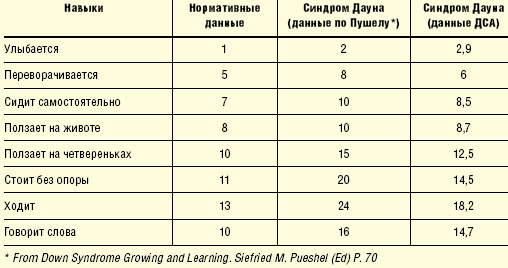
.).
Thus, children with Down syndrome go through the same stages of development as ordinary children, and with special education, although somewhat later, they master the same skills.
Today, more than 1,000 families from Moscow and Russian regions receive information support, they are regularly treated and provided with advisory assistance. Such programs are becoming increasingly widespread in our country and neighboring countries.
The modern approach to teaching children with Down syndrome is based on a family-centered model of early assistance, which includes psychological and pedagogical support for parents and is focused on helping parents in raising their children. Much attention is paid to the development of young children (from 0 to 3 years), the prevention of secondary disorders that arise due to concomitant diseases or uneven development of the child. From the first weeks, teachers’ attention is focused on the interaction of parents with the child, motor development, cognitive processes, and the development of communication. From the age of 1.5 years, children begin to attend group classes aimed at socialization and preparation for kindergarten. By age 3, children typically enter kindergarten while continuing to receive additional special education activities. More and more kindergartens are organizing integrative groups, where children with Down syndrome are together with ordinary peers, and celebrate their positive influence on each other. By the age of 8, children enter schools selected according to their level of development. The majority of children study in specialized schools, but there are isolated examples of children with Down syndrome being taught in general education schools.
Of course, only interdepartmental interaction, including health, social protection and education authorities, makes it possible to comprehensively solve the problems of a child with developmental disorders and his family.
Since 2002, active work has been carried out aimed at preventing social orphanhood of children with Down syndrome, as well as changing attitudes towards this category of children in the professional medical environment and in the public consciousness.
The main components of the program are:
- Providing doctors in maternity hospitals with up-to-date knowledge about the developmental characteristics of children with Down syndrome living in families, the possibilities of pedagogical assistance for such children, and tactics for communicating the diagnosis. Information about the program and printed materials about Down syndrome are provided free of charge to maternity care facilities.
- Providing crisis psychological assistance and social support to parents who are at the stage of making a decision about the fate of the child.
- Inclusion of the family in the early assistance service literally from the first days of the child’s life, psychological and pedagogical support in the preschool period and upon admission to school.
The result of the implementation of this program is a steady increase in the number of children with Down syndrome raised in families. Thus, in 2002 in Moscow, approximately 15% of children remained in families, the same as the Russian average, and after 4 years of the program - in 2006 - 50% of children.
Let's talk about this project in more detail.
Many parents remember the words they heard in the maternity hospital for many years. Because Down syndrome is diagnosed immediately after a child is born, parents learn the diagnosis before their relationship with the child has formed, and often even before they see the child for the first time. The way in which the diagnosis is communicated greatly influences the subsequent development of the parent-child relationship and the acceptance of the child, even if the child remains in the family.
The message about Down syndrome destroys the image of the child that parents dreamed of during pregnancy, their plans and ideas about themselves as parents. The significance of this loss determines the intensity and duration of the experience. This process has several phases and ultimately aims to reorganize life in accordance with the new situation.
The first phase (shock) can be described with the words: “This cannot be, this is not happening to me.” It can last from a few minutes to several days. Then comes the reaction phase, which manifests itself in feelings of anger, conflict, distrust, and the search for someone to blame. These feelings often fall on those who happen to be nearby and report the diagnosis. It is important to understand that such behavior is a normal manifestation of this stage of grief, and to try to emotionally support the parents. This phase can last from several days to several weeks.
At the next stage, the adaptive phase begins. Parents gradually accept the fact that their child has Down syndrome, their anxiety noticeably decreases, and they begin to think about immediate needs. This phase can last up to a year. After this, the orientation or reorganization phase begins, when the family masters the role of parents of an unusual child, takes a constructive approach to solving their problems, seeks help from the appropriate services, makes plans for the future, and establishes new relationships.
Unfortunately, parents usually have to make a decision about the fate of the child while he is in the maternity hospital, that is, within the first few days after his birth. At this time, they are in a shock or reactive phase, and in this state it is almost impossible to make an informed decision. The ability to delay a choice gives them the time they need to adapt. The Early Help Center has recorded about 30 cases in which parents took their child home several days or months after abandonment.
The doctor in the maternity hospital who reports the diagnosis is also under stress caused by the failure of the newborn to meet his expectations, the need to convey unpleasant news, the expected reaction, etc. In addition, he turns out to be the only person to whom parents can turn, and he has to answer the question: “What does this mean?”, presenting pedagogical information about the development and socialization of the child, and also provide psychological support to the mother, answering the question: “What to do now?”
Without sufficient psychological preparation, doctors often act at the expense of their mental strength, “trying the situation on themselves.” Often it is difficult for a doctor to determine the boundaries of his responsibility, and he, sincerely wanting to help parents, advises them to abandon the child, based on their own ideas and their psychological resources. In this case, it turns out that the doctor advises to abandon a child who is not his own, and the parents have to abandon their own.
The mother's reaction, confusion, tears, and aggressive behavior also cause a desire to help her, and she is often prescribed medications that reduce the intensity of grief, but slow down its experience.
Understanding the limits of one’s capabilities and responsibilities, and the opportunity to invite a psychologist, teacher or representative of the parent association make the task facing them easier for doctors.
Let's take a closer look at what is important to do in the maternity hospital:
- congratulate the parents on the birth of a child, list the usual positive things in such cases: gender, height, weight, etc.;
- talk about his problems, examination plan and necessary medical measures;
- bring the baby to the mother, try to maintain breastfeeding, since this is extremely important for the child’s health, improving his contact with the mother and the development of speech in the future;
- provide parents with general information about Down syndrome, avoiding predictions, since the development of a newborn child cannot be predicted;
- support any decision of the parents about the future fate of the child;
- It is not permissible to agitate parents to make this or that decision, since we do not fully understand the circumstances of the life of this particular family and cannot share with them the responsibility for the jointly made decision;
- By kindly questioning parents about their decision, we bring them back to their feelings, their life circumstances, and their own motivations and responsibilities. This leads to the fact that they make a more natural decision - not to abandon the child and subsequently take a more active parental position;
- give time to make a decision about the fate of the child, since the condition of the parents after reporting the diagnosis often does not allow them to make an informed choice. Arrange, if necessary, a meeting with other family members or a psychologist;
- provide information about organizations where the family can receive support in the future. If the child still has medical problems, he should be sent to a medical institution; if he has developmental problems, he should be sent to a psychological or pedagogical institution. These could be educational services, parent mutual support groups, social services, etc. The best option, of course, is the early intervention service, since the family-centered model of early intervention allows parents to receive psychological support when contacting about the child's development.
Starting work with the family at the stage of the maternity hospital, including the family in the early intervention service, with the subsequent transition of the child to kindergarten, school and employment projects for adults, ensures the development, training and socialization of children, and also gives their parents the opportunity to work and lead a normal life life.
T. P. Medvedeva , Moscow
